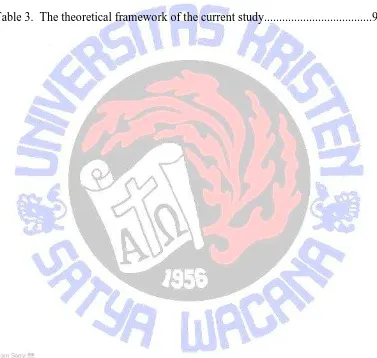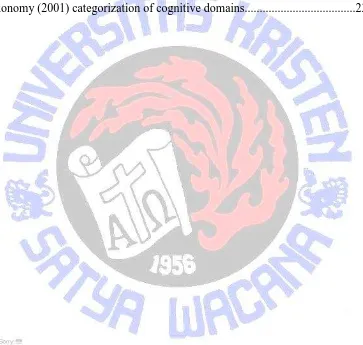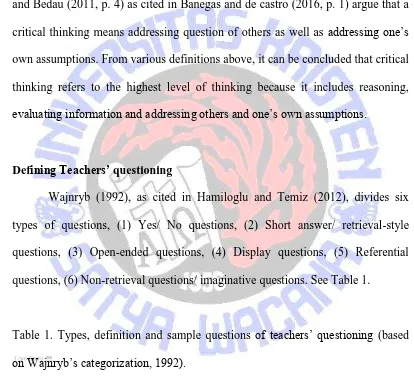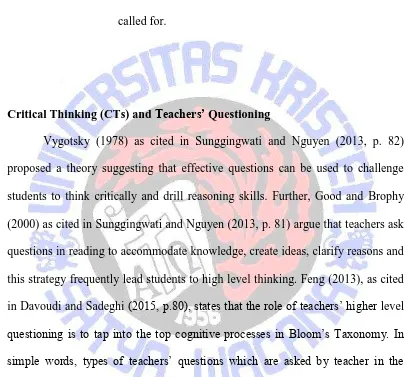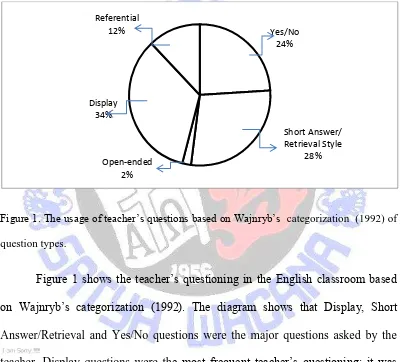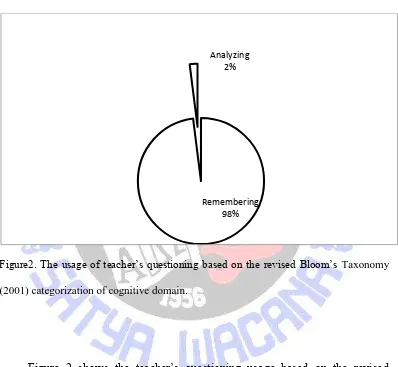i
TEACHERS’ QUESTIONING IN THE ENGLISH LANGUAGE
CLASSROOM
THESIS
Submitted in Partial Fulfillment of the Requirements for the Degree of
Sarjana Pendidikan
IKHA HARI PUJIANI 112013041
ENGLISH LANGUAGE EDUCATION PROGRAM FACULTY OF LANGUAGE AND ARTS UNIVERSITAS KRISTEN SATYA WACANA
vi
COPYRIGHT STATEMENT
This thesis contains no such material as has been submitted for examination in any course or accepted for the fulfillment of any degree or diploma in any university. To the best of my knowledge and belief, this contains no material previously published or written by any other person except where due reference is made in the text.
Copyright @2017. Ikha Hari Pujiani and Joseph Ernest Mambu, Ph.D.
All rights reserved. No part of this thesis may be reproduced by any means without the prior written permission of at least one of the copyright owners or the English Department of Satya Wacana Christian University, Salatiga.
vii
COPYRIGHT STATEMENT ………...vi
TABLE OF CONTENTS ………...vii
Critical Thinking and Teachers’ Questioning...6
Theoretical Framework...8
viii
Teacher’s Questioning in terms of types... 13
Type of Teacher’s Questions Asked... 15
Teacher’s Questioning in terms of Critical Thinking...24
CONCLUSION... 27
ACKNOWLEDGEMENT... 29
ix
LIST OF TABLES
Table 1. Types, definition and sample questions of teachers’ questioning (based
on Wajnryb’s categorization, 1992)...5
Table 2. Definitions and sample questions (based on Anderson & Krathwohl, 2001)...6
x
LIST OF FIGURES
Figure 1. The usage of teacher’s questions based on Wajnryb’s categorization (1992) of questions...14
1
TEACHERS’ QUESTIONING IN THE ENGLISH LANGUAGE
CLASSROOM
ABSTRACT
The investigation concerning the use of teacher’s question has been
significant to conduct since it is one of important techniques in EFL classroom
context (Behnam &Pouriran, 2009). This study aims to identify types of teachers’
questions and cognitive domains which are developed by asking certain questions in the context of English language teaching (ELT) in a Junior High School in Salatiga. The observation was conducted three times. The data analyzed were
based on the Wajnryb’s categorization (1992) in terms of type of questions that a teacher asked in the English classroom. Then, the revised Bloom’s Taxonomy as cited in Anderson and Krathwohl (2001) is used to analyze which cognitive domains are developed by asking certain questions in the English classroom. The results show that the teacher asked Yes/ No, Short Answer/Retrieval style, Open-ended, Display and Referential questions. Yes/ No, Short Answer/Retrieval and display questions develop remembering area. On one hand, Open-ended and referential questions develop analyzing area.
Keywords :Type of questions, cognitive domains
INTRODUCTION
The term critical thinking is common for teachers. Nickerson (1994)
argues that students need to be taught critical thinking in order to help them to
think amd learn better. According to Duron, Limbach, and Waugh (2006, p. 160)
critical thinkers raise vital questions and problems, formulate them clearly, gather
2
communicate effectively with others. Albrecht and Sack (2000) as cited in Duron
et al. (2006, p. 161) states that most teachers believe developing critical thinking
in their students is of primary importance. In simple words, critical thinking (CT)
is important for students’ learning. Since the students need to think in higher order
thinking.
Vygotsky (1978)as cited in Sunggingwati and Nguyen (2013, p. 82)
suggests that effective questions can be used to provide assistance for student
learning as questioning is an essential factor which contributes to challenge
students existing thinking and promote their reasoning skills. In other words,
teachers’ questioning can enhance students to think critically. Wajnryb (1992) as
cited in Hamiloglu and Temiz (2012) states that there are six different types of
questioning, (1) Yes/ No questions, (2) Short answer/ retrieval-style questions, (3)
Open-ended questions, (4) Display questions, (5) Referential questions, (6)
Non-retrieval questions/ imaginative questions.
The revised Bloom’s taxonomy as cited in Anderson and Krathwohl
(2001)there are different level of cognitive domains, (1) remembering,
(2)understanding, (3) applying, (4)analyzing, (5) evaluating, and (6)creating. According to Feng (2013) as cited in Davoudi and Sadeghi (2015, p. 80) teachers’ higher questioning entails questions that address the top cognitive processes in
Bloom’s Taxonomy. In simple words, the type of teachers’ questioning which can
enhance students to think critically are questions which allow learners to attain the
highest cognitive domains in the revised Bloom’s Taxonomy: analyzing,
3
and Fitrawati (2012, p. 121) argues that higher-level questions can enhance
students to think more critically and not just repeating literal information.
Therefore, I will do a research in a Junior High school in Salatiga. To discuss the
issue of this paper, it is important to consider to what extent the types of teacher’s questions have any relation with students’ critical thinking.
The purpose of this study is to identify teacher’s questioning in terms of
types and how it relates to critical thinking based on the revised Bloom’s Taxonomy. By asking certain questions in the context of English language
teaching (ELT) in a Junior High School in Salatiga. The study about teachers’ questioning and critical thinking has been already done by some scholars, such as
Sunggingwati and Nguyen (2013) and Piro and Aderson (2015) but they focus on
reading skills. This study not only focuses on reading skill but also in general
English lessons that integrate different language skills. The results of this study
are hoped to inform teachers to improve questioning techniques in their
classrooms.
LITERATURE REVIEW
Defining Critical Thinking (CT)
Ennis (1987,1996) as cited in Burbules and Berk (1999, p. 5) states that a
critical person should seek reasons and attempts to be well informed. Furthermore
4
reasons, truth and evidence. Scriven and Paul (1987) as cited in Miekley (2013, p.
144) define critical thinking (CT) as “the intellectually disciplined process of
actively and skillfully conceptualizing, applying, analyzing, synthesizing, and/or
evaluating information gathered from, or generated by, observation, experience,
reflection, reasoning or communication, as a guide to belief and action.” Barnet
and Bedau (2011, p. 4) as cited in Banegas and de castro (2016, p. 1) argue that a
critical thinking means addressing question of others as well as addressing one’s own assumptions. From various definitions above, it can be concluded that critical
thinking refers to the highest level of thinking because it includes reasoning,
evaluating information and addressing others and one’s own assumptions.
Defining Teachers’ questioning
Wajnryb (1992), as cited in Hamiloglu and Temiz (2012), divides six
types of questions, (1) Yes/ No questions, (2) Short answer/ retrieval-style
questions, (3) Open-ended questions, (4) Display questions, (5) Referential
questions, (6) Non-retrieval questions/ imaginative questions. See Table 1.
Table 1. Types, definition and sample questions of teachers’ questioning (based
on Wajnryb’s categorization, 1992).
Types of questions Definition Sample questions
Yes / No questions The question expects
students to give yes/no
Here is a picture of woman.
5
answers. before?
Short answer/
retrieval style
questions
The questions expects
students to give short
Display questions The questions are asked
to request for
information that has
been already known by
the teachers.
What colour is this pen?
Referential
information but instead
Why do you think the writer
was suggested by making
the central character an
6
Critical Thinking (CTs) and Teachers’ Questioning
Vygotsky (1978) as cited in Sunggingwati and Nguyen (2013, p. 82)
proposed a theory suggesting that effective questions can be used to challenge
students to think critically and drill reasoning skills. Further, Good and Brophy
(2000) as cited in Sunggingwati and Nguyen (2013, p. 81) argue that teachers ask
questions in reading to accommodate knowledge, create ideas, clarify reasons and
this strategy frequently lead students to high level thinking. Feng (2013), as cited
in Davoudi and Sadeghi (2015, p.80), states that the role of teachers’ higher level
questioning is to tap into the top cognitive processes in Bloom’s Taxonomy. In simple words, types of teachers’ questions which are asked by teacher in the classroom which can facilitate critical thinking are the highest levels of Bloom’s
Taxonomy. The revised Blooms’ Taxonomy divides different level of cognitive domains (1) remembering, (2)understanding, (3) applying, (4)analyzing, (5)
evaluating, and (6)creating. See Table 2.
Table 2. Definitions and sample questions (based on Anderson & Krathwohl,
7
No Cognitive
domain
Definition Sample questions
1. Remembering Recalling knowledge from
memory
Who?
How?
Where?
When?
2. Understanding Determining the meaning
of graphic messages,
procedure in particular
situation
4. Analyzing Breaking material into
parts and determining how
What is the function of ___?
8
6. Creating Putting elements together
to form a coherent or
functional whole,
reorganizing elements into
a new pattern, and
synthesize parts into
something new.
answer/retrieval style questions do not challenge students to think at higher levels
(critical thinking) of their cognitive capacity. Then, display questions are similar
9
student to think critically. On the other hand, open ended, referential and
non-retrieval/imaginative questions foster students to think at the highest levels
because the types of questions require students to judge a value of an idea. Then,
the revised Bloom’s taxonomy is clear that remembering, understanding and
applying are the area of cognitive domains which require low order thinking. On
one hand, analyzing, evaluating and creating are the area of cognitive domains
that reinforce higher order thinking. Duron et al (2006, p. 160) argues that the
revised Bloom’s Taxonomy which involves critical thinking in analyzing,
evaluating and creating area. On the other hand, remembering, understanding and
applying do not require critical thinking. The theoretical framework of the current
study is hence a synthesis of Hamiloglu and Temiz (2012) and the revised
Bloom’s taxonomy. See Table 3.
Table 3. The theoretical framework of the current study.
Wajnryb
Display Referential Non
retrieval/
10
determining if it requires higher order thinking.
Review of Previous Studies
There are three studies about teacher’s questioning. First, Hamiloglu and
Temiz (2012) investigated the impact of teachers questioning on students learning
11
students’ learning. They found that yes/no, short answers and display questions
are mostly used. On the other hand, open-ended, referential and non
retrieval/imaginative questions are rarely asked by teachers
Another study was conducted by Sunggingwati and Nguyen (2013) who
found that usually teachers asked questions in the classroom based on questions
provided in the textbooks. Another finding which are found by Sunggingwati and
Nguyen (2013) is the teachers relied on the textbooks for pedagogies for teaching
reading and for the kinds of questions they asked to assist in reading
comprehension. The teachers were exposed mainly to low-level questions. Then,
Sunggingwati and Nguyen (2013) suggest that teachers should encourage students
to use skills in top cognitive level of Bloom’s Taxonomy. Sunngingwati and Nguyen (2013) also used Raphael’s Taxonomy, (1) On My Own, (2) Author and
Me, (3) Think and Search and (4) Right There as the types of questions .
The study about teachers’ questioning also have been done by Hayati et al.
(2012). This study aims to know the level of questions used in English Zone book.
They use Bloom’s taxonomy as level of questions. They found that the questions
in level knowledge were 42.9%, comprehension level were 30.4 %, application
level were 3.4%, analysis level were 21.4 % and synthesis level were 1.5 %. The
questions in level of evaluative were not used.
Since there are no study of teachers’ questioning in the classroom and critical thinking in Indonesia, especially in Salatiga which refers to the revised
Bloom’s Taxonomy and Wajnryb’s categorization, in this study I address this
12 THE STUDY Research Questions
The study focuses on identifying the types of questions that teacher use in
classroom. I use Wajnryb’s categorization as type of questions that teachers use.
Then, I use the revised Bloom’s Taxonomy in terms of critical thinking. To address the relationship between critical thinking and teachers’ questioning in this
paper, two research questions are raised: “What types of questions are asked by the teachers in a Junior high school under investigation?” and “Which cognitive
domains seem to be developed by teachers when asking certain questions?”
Context and participants
This research was conducted in a Junior high school in Salatiga, Central
Java. The participants were one English teacher and students in three classes. I
selected the participants using convenience sampling. The idea of convenience
sampling is a researcher selects the participants based on convenience. According
to Ary et al. (2010) convenience sampling is perhaps better than nothing at all.
Data Collection
The study is conducted by class observation. Class observation is to
observe teachers’ questioning in terms of types and critical thinking. The
observation protocol is based on the theoretical framework. ( See Table 3 again).
Data Analysis
After conducting classroom observations, I transcribed the data. Then, I
13
categorization. Then, I categorized the teachers’ questions which are already
transcribed based on the revised Bloom’s taxonomy to identify which cognitive
domains are developed by asking the questions. My supervisor and I also checked
the categorize. It is important to know that teachers’ questions that require students to use higher order or critical thinking depend on the numbers of open
ended, referential and non retrieval/imaginative questions (see Table 3).
FINDING AND DISCUSSION
Observation related to teachers’ questioning in the English language classroom were done in three classes in one of Junior High School in Salatiga.
This section discusses types of teachers’ questions based on Wajnryb’s categorization (1992) and cognitive domains in terms of critical thinking based on
the revised Bloom’s Taxonomy as cited in Anderson & Krathwohl (2001). Firstly,
the discussion about teacher’s questions and cognitive domains as related to
critical thinking is presented. Then, in the next-sub section, the discussion in term
of questions type is done by presenting some examples of teacher’s questioning in
14 Teacher’s Questioning in terms of Types
Figure 1. The usage of teacher’s questions based on Wajnryb’s categorization (1992) of
question types.
Figure 1 shows the teacher’s questioning in the English classroom based on Wajnryb’s categorization (1992). The diagram shows that Display, Short
Answer/Retrieval and Yes/No questions were the major questions asked by the
teacher. Display questions were the most frequent teacher’s questioning; it was used 34% from the total of questions usage. The second position with 28% of
classroom usage is short answer/ retrieval-style questions. Yes/No questions
follow in the third position with 24% of classroom usage. Figure 1 illustrates the
frequency of referential and open-ended questions. Referential and Open-ended
15
questions were only asked in the English classroom with each 12% and 2% of
usage respectively. Moreover, the usage of Non-retrieval/Imaginative questions
could not be found in the English classroom.
Type of teacher’s questions asked
This sub-section discusses the type of teacher’s questions asked in the classroom. Some examples of teacher’s questions in the English classroom are presented.
1.Yes/No Questions.
The teacher discussed fable entitled Peacock and Cockatoo. To deliver the
material about fable, the teacher asked questions whether the students know
about fable or not. The teacher may expect the students to answer Yes or No.
Then, the students answer Yes because the students may already know what
fable is from Bahasa Indonesia lesson. Example 1 below shows the evidence of
the teacher asked Yes/No questions in the classroom:
Example 1
→ Teacher : I will tell you topic for the last material about narrative,
especially about fable. Do you know fable?
16
Example 1 shows an example of Yes/ No questions. The question “Do you know fable?” can be categorized as Yes/No questions because it expects the students to give yes or no answers. As Wajnryb’s (1992) stated that Yes / No
questions expect the students to give yes or no answers.
Example 2 also provides the evidence of Yes/No questions. The teacher
showed a picture of cockatoo to the students. The teacher asked whether cockatoo
is popular or not. Then, the students answered “Yes”. One of students added with
some explanation that cockatoo is very popular in Bali. Below is one of sample
Yes/ No questions which are asked by the teacher :
Example 2
question, the teacher wanted to know whether the students know that cockatoo is
popular or not. After the students know that cockatoo is very popular, they added
“It is very popular in Bali”. The question “Is it very popular?”can be categorized
in Yes/ No questions based on Wajnryb’s (1992) categorization. It seems that the
teacher only wants the students to give yes or no answers without reasons.
17
The teacher asked questions related to notice that the students can find in
front of the school. Then, the students answered it in Bahasa Indonesia. The
teacher may expect the students to answer only the notices that the students can
find in front of the school. I also provide example 3 which included in short
answer/ reteieval-style questions :
Example 3
→ Teacher : What did you notice in front of our school?
Student : Prima.
Student : Harap Tenang Ada Ujian.
Teacher : If in English ?
Student : Be quiet, there is an exam!.
Example 3 demonstrates example of Short Answer/Retrieval-style
Questions. Since Wajnryb’s categorization (1992) stated that short
answer/retrieval-style questions are those which expect students to give short
answers. The students did not need to give reasons while answering.
The second example of short answer/ retrieval style questions also
ilustrated in example 4. The teacher showed a picture of a peacock to the
students before reading the fable “Peacock and Cockatoo”. The teacher asked
18
expected the students to give name of place only. Below is one of questions
which can be categorized in short answer/ retrieval style questions :
Example 4
→ Teacher : Where do you meet the peacock ?
Student : Zoo
Wajnryb’s categorization (1992) stated that short answer/retrieval-style
questions only need short answers without less structure concentration. The
question “Where do you meet the peacock?” did not require the students to give
long answers. The teacher expects the students to give the answer the place that
the students can meet peacock.
3.Open-ended Questions
Open-ended Questions also can be found in example 5. In example 5, the
teacher asked questions about moral value in fable entitled “Peacock and Cockatoo”. Since the students can not find the answers in reading text, they keep
silent for a while. The students tried to answer in Bahasa Indonesia. Then the
teacher help them to translate it in English. The example below showed example
of open-ended questions :
Example 5
19
(Keep silent)
Teacher : Anyone please!
Student : Jangan membanggakan dirimu sendiri.
Teacher : What is in English ?
Student : Don’t...
Teacher : Okay, Don’t What?
Example 5 shows an example of open-ended questions. As the minor type
of questions which are asked in the classroom, open-ended questions need
analysis from the students. As Wajnryb’s (1992) describes open-ended questions
as questions that evokes open-ended answers based on students’ ideas or
analyses. By asking the questions the students seem to use students’ analyses
first. The teacher asked the students to tell the moral value from fable entitled
Peacock and Cockatoo. By asking the questions, each students may have
different answers based on their analyses.
4.Display Questions
The example of display questions are showed in example 6. Example 6
told that the teacher is asked questions which already known by her. When the
20
the students can find the notice in front of the school. Below is example of
display questions :
Example 6
→ Teacher : Where can we probably find the notice?
Student : In front of the school.
Student : Everywhere?
Teacher : Where?
Student : Around the school.
Example 6 demonstrates an example of display questions. According to
Wajnryb (1992) display questions is questions which are asked to request for
information that has been already known by the teachers. The questions “where can we probably find the notice?” seem to be display questions. Since the
teacher already knows that the place to find the notice from the notice but the
teacher still asks to the students. Display questions check students’
understanding about a topic (Wajnryb,1992). In other words, the teacher only
wants to check students understanding about the notice “SILENCE, EXAM IN PROGRESS.”
Further, Example 7 also ilustrates the example of Display Questions.
21
fable. The teacher asked the students to mention parts in fable in Bahasa
Indonesia. The teacher already knew the parts of fable without ask to the
students. Since the teacher asked parts in fable and already knew the answers. In
the same situations, the students also knew the answers from Bahasa Indonesia
lesson. It can be categorized in display question. I also provides the example of
display questions in Example 7 :
Example 7
→ Teacher : If you know fable in Bahasa Indonesia. How many part of them?
Student : Three.
→ Teacher : What are they?
Student : Pembukaan, masalah dan cara penyelesain masalah.
It seems to be one of criteria in display questions that the teacher requests
for information that has been already known by the teachers (Wajnryb,1992). The
questions “How many part of them?” and “ what are they?” are display questions.
The teacher tried to focus on asking structures of fable. Long and Sato (1983) as
cited in Qashoa (2013, p. 54) stated that display questions designed to elicit or
display particular structures.
22
Example 8 demonstrates the example of referential questions. The teacher
discussed part in peacock. The teacher wanted to know students’ opinion about
their favorite part in peacock. The example below can be ilustrated as referential
questions :
Example 8
→ Teacher : Which part of your favorite in Peacock ?
Student : Tail.
Student : Feathers.
Example 8 demonstrates as an example of referential questions. As the
minor type of questions are asked in the English classroom. According to
Wajnryb’s categorization (1992) referential questions are those which seek for
new information. Before the teacher asks the students, the teacher did not know
the favorite part of peacock based on the students’ opinion. The question is one of
criteria in referential questions which seek new information from the students
(Wajnryb,1992).
Example 9 provides the questions of referential questions. Since the
teacher wanted to know about the topic conversations that the students talk with
their friend. If the teacher did not ask the students about the topic, the teacher will
not know the topic of their questions. Below is one example of referential
23
Example 9
Teacher : What will they talk each other if they meet?
Student : Food.
Teacher : Yes, talking about food. What’s else?
Student : Enemy.
Teacher : Who is the enemy of peacock and cockatoo?
Student : Human.
→ Teacher : Okay,Human. What do you usually talk with your
friends if you meet?
Student : Good places.
Example 9 shows another example of referential questions. The teacher
asked the questions “what do you usually talk with your friends if you meet?”
The teacher attempted to seek new information from the students about the topic
of conversation if the students and their friends meet. Long and Sato (1983) as
cited in Qashoa (2013, p. 54) argued that referential questions focus on giving
opinion and subjective information. As a response to teachers’ questions, the students deliver the new information to the teacher that the students talk about
good places if they meet with their friends. Students‘ responses the new
24
Teacher’s Questioning in terms of Critical Thinking
Figure2. The usage of teacher’s questioning based on the revised Bloom’s Taxonomy
(2001) categorization of cognitive domain.
Figure 2 shows the teacher’s questioning usage based on the revised Bloom’s Taxonomy (2001) categorization of cognitive domains which related to
critical thinking. The diagram illustrates that remembering area is the major
cognitive domains as closer to one hundred percent (98%) of the total frequency.
Further, Analyzing area constitutes only 2% of the total frequency. Moreover,
other cognitive domains were not found by asking the questions.
Remembering 98% Analyzing
25
Teacher’s questioning in term of Critical Thinking
This sub-section specifically discusses which cognitive domains are
develop by asking the questions. The finding and discussion presents with the
help of some examples.
1.Remembering
One way to check students’s understanding through recalling the informations what they have learned before. In this case, the teacher asked the
students about the idea of fable which already learned by the students. The
example below showed remembering area of cognitive domais based on the
revised Bloom’s Taxonomy as cited in Anderson & Karthworl (2001) :
Example 10
→ Teacher : Can somebody tell me what is fable as far as you know?
Student : Story about animals.
Teacher : That’s good. Is there any explanation about part of fable?
Student : Yes.
→ Teacher : Can you mention it ?
Student : Orientation.
26
Student : Resolution.
Example 11
→ Teacher : If you know fable in Bahasa Indonesia. How many part of them?
Student : Three.
→ Teacher : What are they?
Student : Pembukaan, masalah dan cara penyelesain masalah.
Examples 10 and show examples of remembering. According to the
revised Bloom’s Taxonomy as cited in Anderson and Krathwohl (2001),
remembering is recalling knowledge from the memory. Remembering includes
what, where, when, who, why and how questions. See Table 2. In example 10
the teacher asked questions “Can somebody tell me what is fable as far as you know?” The teacher only wanted recall information from the students. Although
the teacher did not ask questions to the students because the teacher already
knows the answers. The teacher did not require the students to analyze or give
idea in the topic. According to the revised Bloom’s Taxonomy as cited in
Anderson and Krathwohl, (2001) remembering only recite previously learned
information. The questions in examples 10 and 11 may do not require the
students to analyze or synthesize the questions into something new. In simple
words, the majority of questions which are asked in the English classroom
27 2.Analyzing
Example 13
Discussing moral values in fable “Peacock and Cockatoo”
→Teacher : Can you tell me the moral value from the cockatoo ?
( Keep silent )
Teacher : Anyone please.
Student :Jangan membanggakan dirimu sendiri.
Teacher : What is in English ?
Student : Don’t...
Teacher : Okay, Don’t... What ?
( Keep silent )
Teacher : Proud is kata?
Student :Sifat.
Teacher :So...?
Student : Don’t proud.
Teacher :No. You must add one word before proud.
(After for a while )
Student : Don’t be proud.
Example 13 shows the questions which might develop students’ analytical
thinking.The students must analyze what the moral value that they can get from
the fable entitled “Peacock and Cocktaoo”. In other words, there is process in
28
taxonomy as cited in Anderson and Krathwohl, (2001) stated that analyzing is
breaking material into parts and determining how the parts relate one another.
The teacher tries to reveal one parts in fable whis is moral value and asked
them to reflect in their real life. In other words, they think and analyse before
said it.
CONCLUSION
This study was conducted with the aims of identifying types of
teachers’ questions and cognitive domains developed by asking certain
questions in the context of English language teaching (ELT) in a Junior High
School in Salatiga. As a result of observation, it was found that Yes/No
questions, Short answer/retrieval-style questions, Display questions as the
major questions which are asked by the teacher in the classroom. Then,
open-ended questions and referential questions as the minor type of questions are
asked in the classroom. In other hand, non-retrieval/ imaginative questions is
never asked by the teacher. It was also found that remembering area may
develop by asking yes/no ,short answers and display questions. When the
teacher asked open-ended and referential questions, it may develop analyzing
area. Based on the findings, it shows that the teacher never used
non-retrieval/imaginative questions. Then, the teacher rarely used open-ended and
referential questions since those type of questions consider as type of questions
which can foster students’ critical thinking. In other words, the teacher must consider to use type of questions which can foster students to think critically.
29
higher order thinking area, Analyzing, Evaluating and Creating area will be
develop.
Lastly, I hope that the English teacher may consider in using
non-retrieval/imaginative questions since this type of questions can foster students
to think critically. By asking non-retrieval/imaginative questions, creating area
will be developed. The students can think more critically as their preparation in
their future. This research was only conducted in limited period of data
collection and only focused in one English teacher in one Junior High School
in Salatiga. As a conclusion, I believe that this research can be developed into
larger scale in the future. The future research of this topic may allow the
researchers into wider area and more participants. Then, the future researchers
can include the students as the main focus to give responses related to critical
30
ACKNOWLEDGEMENT
First of all, I would like to give my biggest gratitude to the most merciful,
ALLAH SWT, without ALLAH SWT I am nothing. I would also never be able
to finish my thesis without his blessing. Second, I would give my gratitude to my
supervisor, Joseph Ernest Mambu, Ph.D , whom I know as dedicated person in my
thesis. He is not only my supervisor, he is an angel that my God sends to me. He
is very humble and patient. He shares all of his knowledge to me. He makes me
aware the critical issue that other people never aware about that. I am proud
because I can finish my thesis with him. Third, I would like to thank to my
second reader, Athriyana Santye Pattiwael, M.Hum of her feedback and her helps
examining my thesis. She also helps me to become open minded person.
I would like give my gratitude for my parents, and my little sister who
always accompany me all night long to do my thesis. Further, I would like to
thank to my friends, especially Triple I, Ivora Yesica Princes and Intan Risky
Permatasari. They always motivates me to stay in FBS. I also give my gratitude to
“ Doyan Makan gengs” , Ayink, Ohani and Oyeng. Moreover, I would like to
thank for one English teacher in Junior High School in Salatiga as my
interviewee. Thanks for her willingness to give me permission observe in her
31
REFERENCES
Anderson, L. W., &Krathwohl, D. R. (2001). A taxonomy for learning, teaching, and
assessing: A revision of Bloom’s Taxonomy of educational objectives. New York:
Longman.
Ary, D., Cheser, L., & Sorensen, C. (2010). Introduction to research in education(8th
ed.). Wadsworth: Cengage Learning.
Benham,B.&Pouriran,Y.(2009).Classroom discourse: Analyzing teacher/learner
interactions in Iranian EFL task-based classroom. Porta Linguarum,117-132.
Burbules, N.C &Berk. R. (1999). Critical thinking and critical pedagogy: Relations, differences, and limits. New York, NY:Routledge
Davoudi, M.&Sadeghi, N.A. (2015). A Systematic Review of Research on Questioning
as A High Level Cognitive Strategy. Journal of English Language Teaching,8,
76-90.
Duron, R, Limbach B, &Waugh ,W. (2006). Critical Thinking Framework For Any
Discipline. International Journal of Teaching and learning in Higher Education,
17(2),160-166.
Hayati, D&Fitrawati. (2012). Level of Question Used in English Textbook. Journal of
English Language Teaching, 1(1),119-128.
Hamiloglu, K&Temiz,G. (2002). The impact of Teacher Questions on Student Learning.
Journal of Educational and Instructional Studies In The World, 2(2), 1-8.
Miekley, P.J. (2014). What makes critical thinking critical for adult ESL students. The
32
Nickerson, R S. (1994). The teaching of thinking and problem solving. In R.J.Stemberg
(Ed),Thinking and problem solving(pp.121-132). San Diego, CA: Academic
Press.
Piro, J & Anderson, G. (2015). Discussions in a Socrates Cafe : Implications for Critical
Thinking in Teacher Education. The university of Melbourne Libraries,37,
265-283.
Qashoa, H. S. (2013). Effects of Teacher Question Types and Syntactic Structures on
EFL Classroom Interaction. The International Journal of Social Sciencies. 7(1),
52-62.
Stroupe, R. R. (2006). Integrating Critical Thinking Throughout ESL Curricula. TESL
Reporter, 39(2), 42-60.
Sunggingwati, D.&Nguyen,H.T.M. (2013). Teachers’ Questioning in Reading Lessons: A
Case Study in Indonesia. Electronic Journal of Foreign Language Teaching,
10(1), 80-95.
Wajnryb, R. (1992). Classroom observation tasks: A resource book for language
teachers and trainers. Cambridge: Cambridge University Press.
Wangru, C. (2016). The research on Strategies of College English Teachers Classroom
